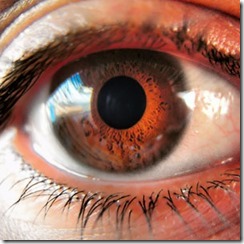From Popular Mechanics: Twenty-twenty vision? Big deal. UltimEyes could train your brain to see in 20/7.5.
Jamie Allen/Getty Images
When a major league baseball pitcher throws a 95-mph fastball, only about 400 milliseconds—the duration of a blink—pass before the ball rockets over the plate. And a batter gets less than half that time to decide whether to swing, and where. Baseball players, then, could reap huge benefits from being able to probe a baseball farther from their eyes. And that inspired Aaron Seitz, a neuroscientist at the University of California, Riverside, who has created a new, publicly available app that conditions users to see farther on or off the baseball diamond.
In a study published this week in the journal Current Biology, Seitz worked with 19 players on the University of California, Riverside, baseball team, and showed that his app UltimEyes lengthened the distance at which the players could see clearly by an average of 31 percent. After using the app for 30 25-minute intervals, players saw an improvement that pushed many of them beyond normal 20/20 vision, including seven who attained freakishly good 20/7.5 vision—meaning that at a distance of 20 feet, they were clearly seeing what someone with normal vision could see at no farther than 7.5 feet away.
"We were using standard, on-the-wall eye charts," Seitz says. "Normally, you stand 20 feet away, but our charts only measured down to 20/10 [vision]. So we moved some of these players 40 feet away from the eye chart and they were still reading the low lines. I was shocked." Seitz has also calculated that, by measuring the improvement in batting of his test subjects against other players, his app made the team score enough extra runs to win at least four additional games throughout the season.
Although Seitz’s app seems quite implausible, its effects are indeed real, says Peggy Series, a neuroscientist at the University of Edinburgh, who was not involved in the study or the development of UltimEyes. "These results are, in fact, very similar to what’s already been proven in the lab," Series says. "It’s very exciting. The fact that the app is improving the players’ visual acuity is not as surprising to me as that the improvement might actually help in playing baseball."
The Brain—Not the Eyes
Despite its name, UltimEyes has little to do with improving the physical eye or eye muscles. Rather, the app works by exploiting recent insights into when and how the adult brain can be fundamentally rewired—a concept known as neuroplasticity.
"Within the last decade or so we’ve started to learn that brain fitness is a bit akin to physical fitness," Seitz says. "If we exercise our brain in the proper ways, pretty much everything that the brain does should be able to be improved."
UltimEyes exercises the visual cortex, the part of our brain that controls vision. Brain researchers have discovered that the visual cortex breaks down the incoming information from our eyes into fuzzy patterns called Gabor stimuli. The theory behind UltimEyes is that by directly confronting the eyes with Gabor stimuli, you can train your brain to process them more efficiently—which, over time, improves your brain’s ability to create clear vision at farther distances.
Here’s how the app looks in action: UltimEyes presents you with the increasingly difficult challenge of identifying faint and fuzzy Gabor stimuli, which are shown against a hazy, gray background. Among other tests, the blurry blobs might slowly materialize on the screen, or you might be tasked to find multiple blobs as they grow slightly less faint. Each successful find is rewarded with a Pavlovian noise that sounds almost exactly the arcade game Pong. It isn’t exactly fun, but it’s challenging, and the sessions are short.
Seitz likens the app’s effect to leaving an optometrist with a fresh prescription. "There’s much more definition on the leaves on trees," he says. In his recent study several of the ball players also noted they were "able to distinguish lower contrasting things," and that their "eyes feel stronger, they don’t get tired as much."
Open Questions
Despite this success, however, many of the details of exactly why and how UltimEyes locks into adult neuroplasticity are still up in the air. "These Gabor stimuli have proven to be very good at activating visual cortex and causing very strong improvements," Series says, but adds that it’s unclear exactly what is happening in the brain to cause these.
And the researchers are still unable to say why the app improves the vision of some people much more than others, or one eye more than the other. How long the vision benefits last is also not fully understood.
But the neuroscientists are nonetheless excited. Many of the baseball players in this study started with somewhat above-average vision, including the seven that acquired the astounding 20/7.5 vision. Yet even those who started the tests with good eyesight made impressive gains; to Seitz, this implies that the physical limit of human vision may be much higher than we’ve previously thought. And Seitz, bespectacled and nearsighted himself, is interested in investigating the promise this type of training might have for those with impaired vision, though he emphasizes that the app is not meant to completely reverse or cure visual impairments.
Seitz is already experimenting on how to adapt his neuroscience-grounded approach to brain training for other means. "I’m trying to develop a larger set of programs that address an entire suite of issues," he says. From improving hearing to enhancing memory, Seitz believes that exploiting our neuroplasticity is just a matter of finding the right key that challenges the right neurons.

Leave a Reply
You must be logged in to post a comment.